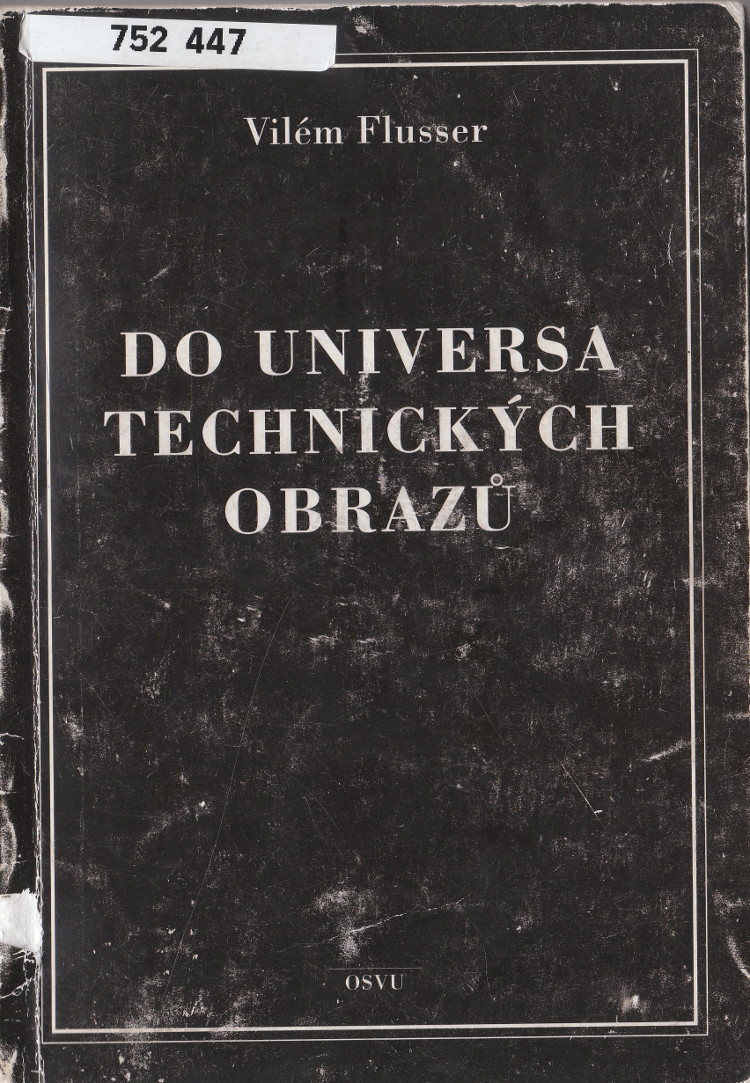Vilém Flusser: Into the Universe of Technical Images (1985–) [DE, HU, CZ, EN]
Filed under book | Tags: · communication technology, computing, cybernetics, database, entropy, image, media, media theory, philosophy, photography, postmodernism, technical image, technology, theory, virtual reality


Poised between hope and despair for a humanity facing an urgent communication crisis, this work by Vilém Flusser forecasts either the first truly human, infinitely creative society in history or a society of unbearable, oppressive sameness, locked in a pattern it cannot change. First published in German in 1985 and now available in English for the first time, Into the Universe of Technical Images outlines the history of communication technology as a process of increasing abstraction.
Flusser charts how communication evolved from direct interaction with the world to mediation through various technologies. The invention of writing marked one significant shift; the invention of photography marked another, heralding the current age of the technical image. The automation of the processing of technical images carries both promise and threat: the promise of freeing humans to play and invent and the threat for networks of automation to proceed independently of humans.
Originally published in German as Ins Universum der technischen Bilder, European Photography, 1985
Czech edition: Do universa technických obrazů
Translated by Jiří Fiala
Publisher OSVU, 2002
ISBN 8023875698
162 pages
English edition
Translated by Nancy Ann Roth
Introduction by Mark Poster
Publisher University of Minnesota Press, 2011
Volume 32 of Electronic Mediations
ISBN 0816670218, 9780816670215
224 pages
Review (Bob Hanke, International Journal of Communication)
Translator (EN)
Publisher (EN)
Ins Universum der technischen Bilder (German, 1985, added on 2016-8-4)
A technikai képek univerzuma felé (Hungarian, trans. József Maleczki, 2001; revised trans. Dalma Török, 2011; HTML, added on 2014-2-14)
Do universa technických obrazů (Czech, Jiří Fiala, 2002, no OCR, added on 2013-4-1)
Into the Universe of Technical Images (English, trans. Nancy Ann Roth, 2011, updated on 2012-7-17)
Vito Campanelli: Web Aesthetics: How Digital Media Affect Culture and Society (2010)
Filed under book | Tags: · aesthetics, computing, digital media, internet, media, media culture, memes, networks, new media, remix, spam, subjectivity, technology, theory, virus, web

“We live in a world of rapidly evolving digital networks, but within the domain of media theory, which studies the influence of these cultural forms, the implications of aesthetical philosophy have been sorely neglected. Vito Campanelli explores network forms through the prism of aesthetics and thus presents an open invitation to transcend the inherent limitations of the current debate about digital culture.
The web is the medium that stands between the new media and society and, more than any other, is stimulating the worldwide dissemination of ideas and behaviour, framing aesthetic forms and moulding contemporary culture and society.
Campanelli observes a few important phenomena of today, such as social networks, peer-to-peer networks and ‘remix culture’, and reduces them to their historical premises, thus laying the foundations for an organic aesthetic theory of digital media.”
Publisher NAi Publishers, Rotterdam; in association with the Institute of Network Cultures at the Hogeschool van Amsterdam, University of Applied Sciences, October 2010
Studies in Network Cultures series
ISBN 9056627708, 9789056627706
276 pages
Reviews: Greg J Smith (Rhizome, 2011), Alessandro Ludovico (Neural, 2011), Regine Debatty (We Make Money Not Art, 2011).
Book website
Interview with the author (Geert Lovink)
Interview with the author (Pasquale Napolitano, Digicult)
PDF, PDF (25 MB, updated on 2019-3-24)
Comments (7)Mercedes Bunz: Vom Speicher zum Verteiler: Die Geschichte des Internet (2008) [German]
Filed under book | Tags: · arpanet, computing, filesharing, history of computing, history of technology, internet, media history, media theory, networks, technology

Das Internet ist kein Speichermedium, es ist ein Verteilungsmedium. Deshalb ist nichts im Internet so beständig wie der Wandel – und das ist von Beginn an so gewesen. Schon in den sechziger Jahren wird die Vernetzung von Computern zugleich als Einkaufsmöglichkeit, als Austausch von Forschungen und als Sicherstellen durch verteilte Kommunikation nach einem Bombenangriff entworfen. Damit wird der Fokus bei diesem Medium immer wieder auf Schnelligkeit und Dynamik und nicht auf seine Beständigkeit gelegt.
Von diesen frühen Planungen der ersten Netzwerke bis hin zum heutigen Internetprotokoll verfolgt das vorliegende Buch die Entstehung und den Wandel dieser Technologie und stellt die wichtigsten Projekte, Visionäre und Ingenieure der Geschichte des Internet vor. Dabei zeigt sich auch: Die Entstehung dieser Kulturtechnik hat keineswegs nur in Amerika stattgefunden. Die Geschichte des Internets entspringt nicht einem Ort, sie folgt vielmehr seiner eigenen Architektur und ereignet sich selbst in Form eines verteilten Netzwerkes. Im Erzählen seiner Geschichte gilt es deshalb auch, einen Paradigmenwechsel zu vollziehen. Weil der Fokus dieses neuen Mediums auf dem Verteilen und nicht auf dem Speichern liegt, ist die Geschichte des Internet im besonderen Maße auch eine Herausforderung für das Denken einer zeitgenössischen Medientheorie.
Publisher Kulturverlag Kadmos, Berlin, February 2008
copyrights Bd. 20
ISBN 3865990258, 9783865990259
147 pages
PDF (updated on 2012-7-25)
Comment (1)
